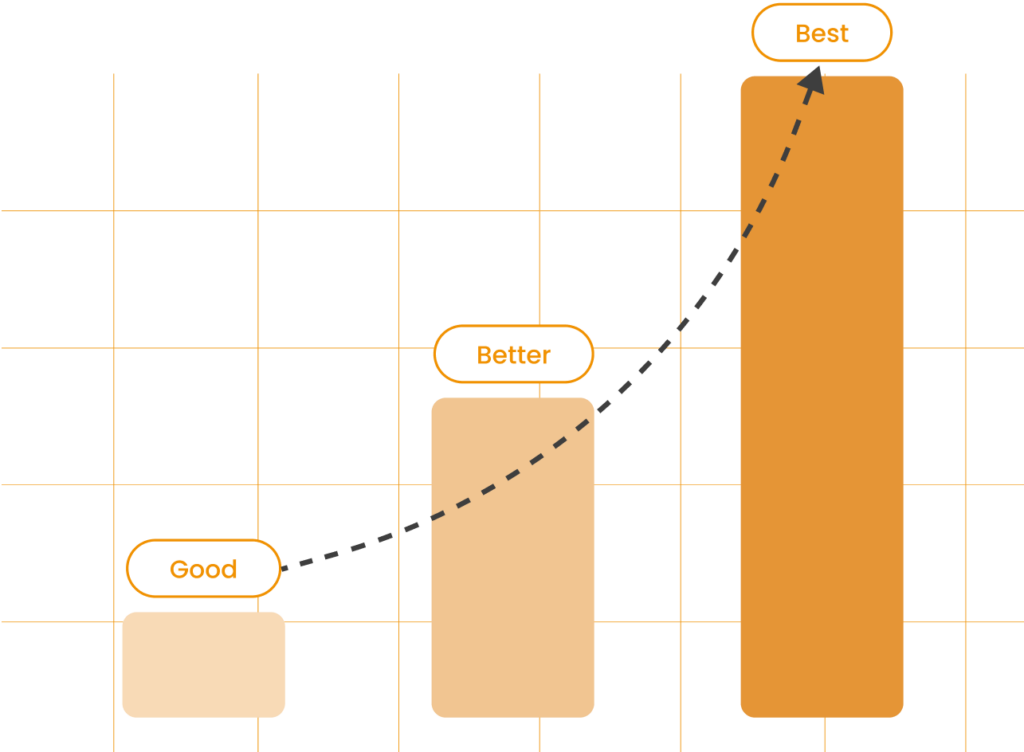📢 📢 📢 FREE Webinar - How the Unconscious Drives You and Your Team’s Success!

📢 📢 📢 FREE Webinar - How the Unconscious Drives You and Your Team’s Success!


My experience has shown: Nothing boosts performance, acceptance, and unity more than pursuing common goals. Whether in sports, businesses, or large-scale events, a clear definition of goals is a key success factor and helps to:
Over the years, I have developed a goal architecture that includes not only clear, factual objectives but also behavioural and interpersonal goals. The PSYfiers goal system is practical and can be flexibly applied to any type of team, group, or corporate work. In this system, we distinguish between three types of goals:
A. Performance Goals – Concrete, measurable outcomes to be achieved.
B. Attitude Goals – The way a goal is achieved, considering values and mindset.
C. Purpose Goals – The overarching meaning behind a goal.
What we call performance goals are often the only type of goals found in many organizations. They define the desired outcomes and are often quantitatively measurable. There are dozens of books on this type of goal, so I won’t dwell on it for long, as many successful models already exist. Personally, I am a strong advocate of the SMART model, which helps formulate such factual goals effectively:
Example of a SMART goal: Instead of saying, “I want to lose weight,” it should be: “I will lose 15 kg by the end of the year by exercising four times a week and burning at least 1,000 calories each time.”
I rarely start a meeting without addressing both performance and attitude goals. While performance goals focus on concrete outcomes, attitude goals define how these outcomes are achieved. They have a significant impact on team dynamics and are a crucial factor in building trust.
The English term attitude encompasses both an internal mindset and an external posture – exactly what our attitude goals aim at. It’s not just about the path, but about the “how”, in terms of values, collaboration, and interpersonal dynamics.
Attitude Goals – An Underrated Element of Collaboration
Attitude goals are often not consciously defined in many companies, associations, or teams. There is often an assumption that corporate culture develops naturally over time or is shaped by unspoken expectations. However, this is precisely where a problem arises: Without clear attitude goals, there is no guidance for behaviors that sustainably lead a team to success.

Strategy vs. Attitude – The Two Perspectives of the “How”
Attitude goals are not about defining the path to achieving a goal – that is the role of strategies and plans. Instead, attitude goals determine the mindset and values with which this path is taken. They answer the question: “How do we want to work together to achieve our goals?” This distinction is crucial. While strategies can be flexibly adjusted, attitude goals provide a stable foundation for trust and collaboration.

Attitude Goals and Corporate Culture
Aren’t attitude goals just another word for corporate culture? Essentially, yes, as both terms pursue the same objective – but only if a clear corporate culture exists and its values have been explicitly defined. This is often not the case, especially in young companies, project teams, or sports teams. In such cases, consciously defining attitude goals can make a significant difference. They help prevent misunderstandings and play a crucial role in success.
Attitude goals don’t need to be formulated in every detail. Often, one or two key values are enough to shape the team’s overall mindset and serve as a guideline for behaviour.
The Example of the 2014 European Athletics Championships in Zurich
A striking example of a successfully defined attitude goal is the 2014 European Athletics Championships in Zurich, where I had the privilege of serving as CEO. Even during the bidding phase, it was established that the fundamental “attitude” of this event would be “Zusammen – Insieme – Ensemble”. This principle was not just an empty phrase but a conscious decision that was reflected in all areas.
What did this mean in practice?

The result: High satisfaction among all participants and the lasting success of the event. Switzerland has since developed into an athletics nation and is now among the top eight European countries in terms of performance. Regarding the percentage of young people who participate in at least one athletics competition per year, Switzerland is even among the top three in Europe.
This development is the result of years of dedicated efforts and a consistently lived attitude based on collaboration and mutual appreciation. The 2014 European Athletics Championships in Zurich demonstrated how a clearly defined attitude goal can significantly influence the success of a major event.
Attitude goals can have an impact both internally and externally.

Der The slogan “Just Do It” was created in 1988 by the advertising agency Wieden+Kennedy for Nike. As part of my work in athletics, I had the opportunity to visit Nike’s headquarters in Beaverton, Oregon, multiple times from 1991 onward. Walking around the campus, I could feel how Nike employees had fully embraced “Just Do It” as an attitude goal. The energy, pace, and decisiveness reflected in the slogan were present in every meeting. At the end of each discussion, people would part ways with “Just do it” or “Let’s do it now.”
This “unofficial” attitude goal was soon adopted by athletes as well. Between 1991 and 2016, I worked with or managed numerous top athletes, primarily in track and field but also in other sports. Many of these athletes were determined to be sponsored by Nike, even if it meant accepting a lower-paying contract or using equipment that wasn’t the perfect fit for them. When asked why, they all gave the same answer: “I want to be part of this ‘Just Do It’ community.”
The slogan and the shared attitude goal that emerged from it played a major role in Nike’s impressive growth. In 1989, the company generated $1.7 billion in revenue and, for the first time, became the world’s largest sportswear manufacturer. By 1995, Nike had surpassed $4 billion in revenue and achieved a net profit of approximately $400 million.
Conclusion: Attitude goals can have an impact both internally and externally:
When Attitude Goals Backfire

Als As CEO of FIFA Marketing AG, I launched a great Fair Play campaign— a project I was proud of for many years. The collaboration with UNICEF, in particular, led to powerful images that conveyed the spirit of FIFA Fair Play in an authentic way.
However, attitude goals must be lived. If values are merely promoted and talked about but not consistently upheld, this inevitably leads to a loss of trust—and ultimately, to the opposite of the intended effect.
Today, I can no longer present the FIFA Fair Play campaign as a success story. The public perception of FIFA has become so deeply associated with scandals and the ruthless behaviour of its top executives that a Fair Play logo always elicits a big lough. What was once a strong attitude goal has been completely undermined by a lack of integrity and inconsistent actions.

Attitude Goals Can Replace an Established Corporate Culture
In today’s fast-paced digital world, especially in young companies or smaller teams, a clearly defined corporate culture is often lacking. Taking the time to consciously establish not only performance goals but also the desired mindset and shared values – attitude goals – is essential for building trust and shaping a well-coordinated, high-performing team.
Attitude goals are not a simple “soft” factor among others but a strategic necessity. They determine how effectively teams collaborate, how conflicts are avoided, and whether a corporate culture emerges that ensures long-term success. Those who recognize this and put it into practice will build not only more capable but also more resilient and trust-based teams.
Organisational theory recognised decades ago that performance goals alone are not enough. To formulate a comprehensive goal-setting framework for companies or organizations, they must be combined with attitude goals. Whenever possible, I integrate performance and attitude goals into purpose goals, which answer the fundamental question: “What do we want to achieve together?”
In his book Start with Why, Simon Sinek advocates starting with the “why” – the deeper emotional purpose behind a company or project – rather than focusing solely on commercial success. In his “Golden Circle” model, Sinek explains that every individual and organisation knows what they do. Far fewer know how they do it. And even fewer know why they do it.
Note: The English word “why” refers both to the reason or cause and to the purpose or “raison d’être”.
The Importance of Purpose Goals
Purpose goals are meant to fill exactly this gap. From a purely mechanistic perspective, one could say that companies exist to generate profits. However, in reality, they are multi-purpose systems that:
Consequently, purpose goals should not primarily appeal to the intellect but rather evoke emotions. They provide employees and customers with an intuitive way to identify with the organization—a raison d’être that goes beyond purely economic objectives. Purpose goals should:
Ultimately, it’s about employees and customers seeing themselves as part of a greater whole and having a rough sense of the direction their collective – be it a company, organization, or association – is aiming for.
To be honest, I haven’t often managed to formulate a truly successful purpose goal myself. Because, let’s face it: it’s difficult. But I have succeeded on occasions. Perhaps the most spectacular example was the 2006 FIFA World Cup in Germany.
The Example of the 2006 FIFA World Cup

The organising committee, led by the legendary Franz Beckenbauer, pursued more than just the goal of delivering a successful FIFA World Cup from a sporting and logistical perspective. They aimed to create a deeper, long-term impact that would change the world’s image of Germany as a nation of war and rigidity. Instead of focusing solely on football or infrastructure, the team developed a broader vision: “Die Welt zu Gast bei Freunden” (literally: The world as guests at friends; as slogan: “A time to make friends”).
In my role as CEO of FIFA Marketing AG, I played a key role in formulating this purpose goal, which ultimately became the official slogan of the event. Additionally, we developed a large-scale “Service und Freundlichkeit” (Service and Friendliness) campaign. Tens of thousands of volunteers, police officers, public transport employees, and many others were trained to welcome guests from all over the world with exceptional warmth. Always at the forefront when it came to leading by example was Franz Beckenbauer. His palpable presence, kindness, wit, and humour inspired an entire nation to reshape its image in a positive way.
This initiative had far-reaching effects:
Already the attempt to formulate purpose goals creates long-term emotional identification.
Purpose goals go beyond purely economic or strategic objectives. They answer the “Why?” in the sense of “What for?” question and foster a deep emotional connection. Companies that clearly define and authentically live their purpose goals are:
As already mentioned, formulating purpose goals is not always easy. However, in my experience, even the mere attempt to define them works wonders – especially when employees are actively involved in the process.
Note, the real impact lies not in formulating purpose goals but in truly living them – even if it doesn’t always work perfectly. People quickly sense whether an attitude is genuine or merely an empty phrase. Those who consistently pursue their purpose goals create a corporate culture that inspires and has a lasting impact.
In recent years, I had the privilege of working with SwissSkills and WorldSkills France. Both are national organisations dedicated to promoting vocational education and young professional talent. SwissSkills organises the Swiss national professional championships and qualifies the SwissSkills Team for international competitions such as WorldSkills and EuroSkills. WorldSkills France pursues the same goals in France and also selects a national team for international championships. Both national teams regularly rank among the top three in Europe.
Key representatives from both national teams, who performed exceptionally well at EuroSkills 2023, were invited to share their thoughts on the topic of “Shared Goals.” The two following videos vividly demonstrate how similar and aligned their responses were.
For me, this is further proof that formulating shared goals, which integrate both performance and attitude goals, is the key to true success stories.

Curious about Mission Team and have a few questions?
Excited to dive deeper into what we offer?
Ready to transform your team with an incredible workshop?
© 2025 Mission Team, Inc. All rights reserved.